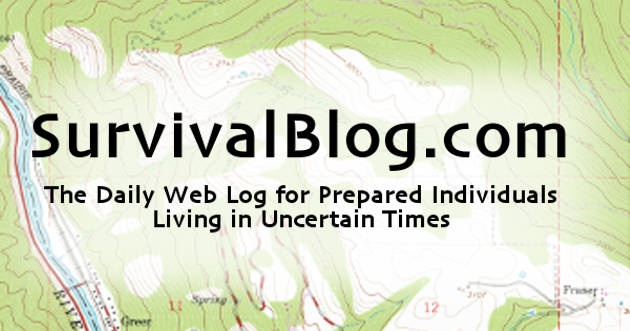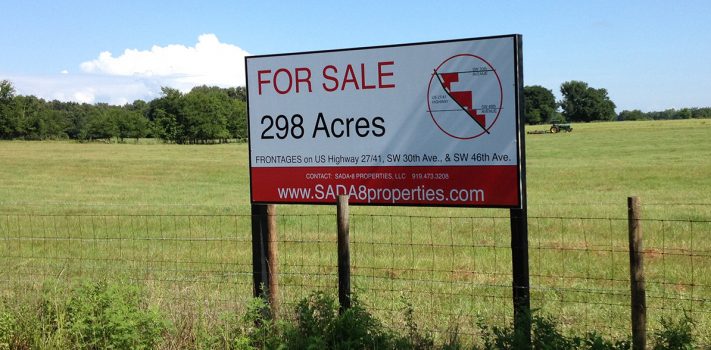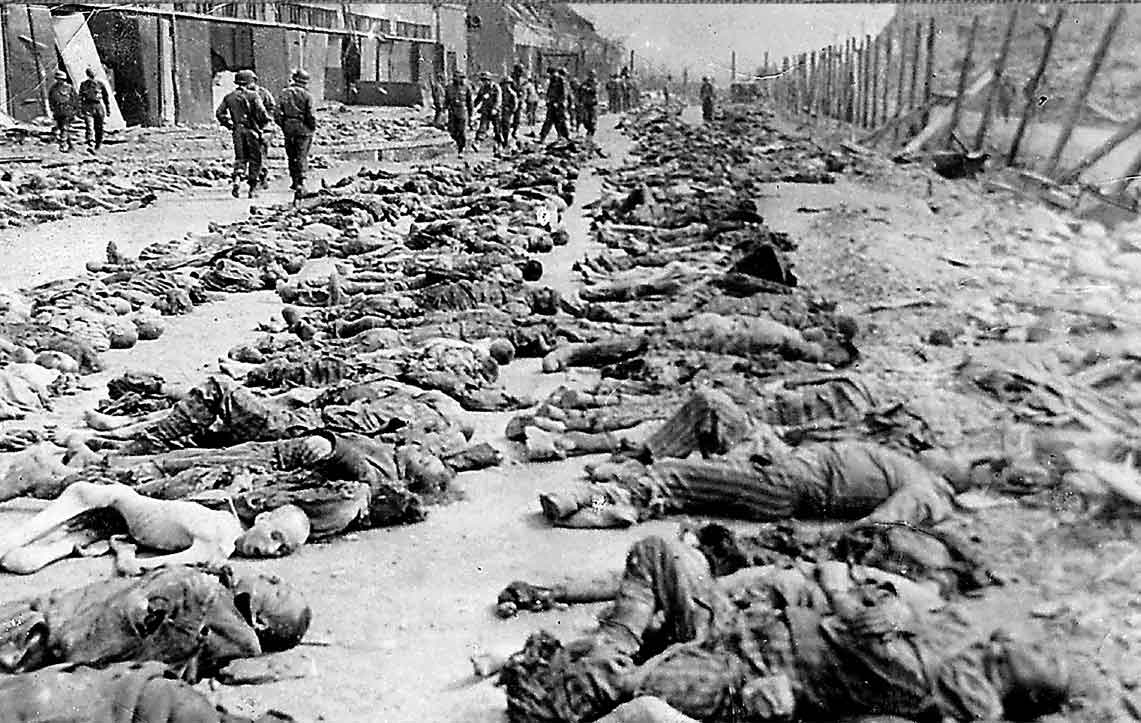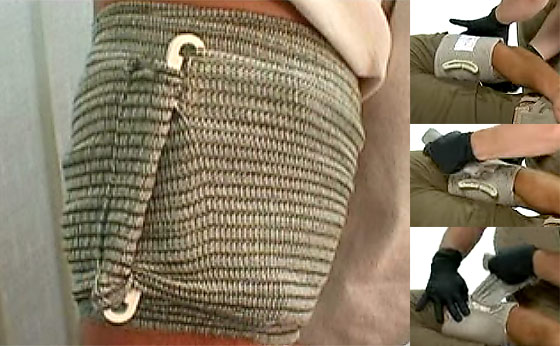“For the day of the Lord is near upon all the heathen: as thou hast done, it shall be done unto thee: thy reward shall return upon thine own head.” – Obadiah 1:14 (KJV)
- Ad Trekker Water Station 1Gal Per MinuteCall us if you have Questions 800-627-3809
- Ad Click Here --> Civil Defense ManualNOW BACK IN STOCK How to protect, you, your family, friends and neighborhood in coming times of civil unrest… and much more!
Preparedness Notes for Friday – December 01, 2017
This is the birthday of novelist Rex Stout (1886–1975)
Continue reading“Preparedness Notes for Friday – December 01, 2017”
- Ad SIEGE belt: the original unmatched action belt. Proven in many unexpected situations on wearers' daily routines & travels. Engineered for extreme durability, performance, comfort & stunning looks. The only effective EDC you can take anywhere.SIEGE STOVES: prep for adventure/crisis with the ultimate ultra-compact survival stove. SIEGE BELTS: prized by those in the know. Blazing fast. Stunning appearance. USA-made.
- Ad USA Berkey Water Filters - Start Drinking Purified Water Today!#1 Trusted Gravity Water Purification System! Start Drinking Purified Water now with a Berkey water filtration system. Find systems, replacement filters, parts and more here.
Round 73 Non-Fiction Writing Contest Winners Announced!
This was a tough contest to judge because we had so many really good articles during this round. However, decisions must be made so without any further ado, Here are the winners. Any article submitted but not published will automatically be rolled over to Round 74.
First Prize goes to Florida Mom for “A Stitch in Time – Part 1” and “Part 2”, published on November 17th and 18th, 2017. She will receive the following prizes:
- A $3000 gift certificate towards a Sol-Ark Solar Generator from Veteran owned Portable Solar LLC. The only EMP Hardened Solar Generator System available to the public.
- A Gunsite Academy Three Day Course Certificate. This can be used for any one, two, or three day course (a $1,095 value),
- A course certificate from onPoint Tactical for the prize winner’s choice of three-day civilian courses, excluding those restricted for military or government teams. Three day onPoint courses normally cost $795,
- DRD Tactical is providing a 5.56 NATO QD Billet upper. These have hammer forged, chrome-lined barrels and a hard case, to go with your own AR lower. It will allow any standard AR-type rifle to have a quick change barrel. This can be assembled in less than one minute without the use of any tools. It also provides a compact carry capability in a hard case or in 3-day pack (an $1,100 value),
- Two cases of Mountain House freeze-dried assorted entrees in #10 cans, courtesy of Ready Made Resources (a $350 value),
- A $250 gift certificate good for any product from Sunflower Ammo,
- Two cases of Meals, Ready to Eat (MREs), courtesy of CampingSurvival.com (a $180 value), and
- American Gunsmithing Institute (AGI) is providing a $300 certificate good towards any of their DVD training courses.
Second Prize goes to K.F. for “Long-Term Preparedness for Your Baby or Toddler – Part 1” and “Part 2”. She will receive the following prizes:
- A Model 175 Series Solar Generator provided by Quantum Harvest LLC (a $439 value),
- A Glock form factor SIRT laser training pistol and a SIRT AR-15/M4 Laser Training Bolt, courtesy of Next Level Training, which have a combined retail value of $589,
- A gift certificate for any two or three-day class from Max Velocity Tactical (a $600 value),
- A transferable certificate for a two-day Ultimate Bug Out Course from Florida Firearms Training (a $400 value),
- A Trekker IV™ Four-Person Emergency Kit from Emergency Essentials (a $250 value),
- A $200 gift certificate good towards any books published by PrepperPress.com,
- A pre-selected assortment of military surplus gear from CJL Enterprize (a $300 value), and
- RepackBox is providing a $300 gift certificate to their site.
Third Prize goes to Wild BillB of OR for “Our Family’s Garden Grain Experiment – Part 1” and “Part 2”. He will receive the following prizes.
- A Royal Berkey water filter, courtesy of Directive 21 (a $275 value),
- A large handmade clothes drying rack, a washboard, and a Homesteading for Beginners DVD, all courtesy of The Homestead Store, with a combined value of $206,
- Expanded sets of both washable feminine pads and liners, donated by Naturally Cozy (a $185 retail value),
- Two Super Survival Pack seed collections, a $150 value, courtesy of Seed for Security, LLC,
- Mayflower Trading is donating a $200 gift certificate for homesteading appliances, and
- Two 1,000-foot spools of full mil-spec U.S.-made 750 paracord (in-stock colors only) from www.TOUGHGRID.com (a $240 value).
Honorable mention prizes ($30 Amazon.com gift certificates via e-mail) have been awarded to the writers of these fine articles:
- “God’s Perfect Bounty: Our Natural Survival Garden – Part 1”, “Part 2”, and “Part 3”, by D.M.
- “Potatoes – A Staple for Food Storage with No Refrigeration”, by Back Yard Gardner
- “Radio Communication methods During Emergencies – Part 1”, “Part 2”, “Part 3”, “Part 4”, and “Part 5”, by R. in N.C.
- “Commuter’s Get Home Bag”, by M.M.
- “Stalking the Night – Part 1” and “Part 2”, by Mark B
- “Thermal Headset for Under $250”, by Ricky B.
Additionally, during Round 73 of the SurvivalBlog writing contest, we had a number of really good accounts of hurricane survival and preparedness. JWR has decided that the authors of these three accounts will receive an autographed hardback copy of his book “Survivors”:
- “Hurricane Preparedness in the Sunshine State – Part 1” and “Part 2”, by D.H.
- “After Action Report on Hurricane Irma”, by Florida Dave
- “Essential Survival Tips from a Hurricane Irma Survivor”, by C.S.
- Ad Survival RealtyFind your secure and sustainable home. The leading marketplace for rural, remote, and off-grid properties worldwide. Affordable ads. No commissions are charged!
- Ad LifeSaver 20K JerryCan Water PurifierThe best water jerrycan you can buy on the market! Mention Survivalblog for a Free Filter ($130 Value)
Hope With A Temporal Leftist Regime- Part 1 , by J.R.V.
Recognition of the inevitability of comprehensive bureaucratization does not solve the problems that arise out of it.—Joseph Schumpeter, Capitalism, Socialism and Democracy
Many of us—including me—worry about the downward arc of liberty, ethics, and economic freedom and contemplate where we might find hope. If you are taking the time to read this article, in all likelihood, I needn’t detail the myriad challenges we face for you either. Rather, the question is: is there any hope? Or are we fated to descend into a new Dark Age, aided and abetted, in the famous words of Winston Churchill regarding National Socialism, by “perverted science”?
Any Reasons To Hold Out Hope?
Notwithstanding those who look forward to the return of Jesus Christ—of which I count myself one—or a spiritual revival, are there any other reasons to hold out hope in the interim? I think there is. It is not a certain hope, but it is a hope that—accompanied by courage, elbow grease, intelligence, and audacity—should give conservatives, libertarians, Constitutionalists, and other allies a reason for positivity. And please note by “audacity”, I do not allude to the book by Barack Obama, who is one of the leading unlights pushing us towards a new Dark Age; rather, I make reference to the words of a true American hero, George Patton, whose motto was “Audacity, audacity, always audacity.” Patton, of course, led the charge in destroying a similar national socialism we see here today.
Continue reading“Hope With A Temporal Leftist Regime- Part 1 , by J.R.V.”
- Ad STRATEGIC RELOCATION REALTYFOR SALE: Self-sustaining Rural Property situated meticulously in serene locales distant from densely populated sanctuary cities. Remember…HISTORY Favors the PREPARED!
- Ad Ready Made Resources, Trijicon Hunter Mk2$2000 off MSRP, Brand New in the case
Economics & Investing For Preppers
Here are the latest items and commentary on current economics news, market trends, stocks, investing opportunities, and the precious metals markets. We also cover hedges, derivatives, and obscura. And it bears mention that most of these items are from the “tangibles heavy” contrarian perspective of JWR. (SurvivalBlog’s Founder and Senior Editor.) Today’s focus is on How to Sell Lots and Land. (See the Tangibles Investing section.)
Precious Metals:
Bored With Gold? Look For Wider Gold-Silver Ratio – Commerzbank
o o o
Stock Market:
The DJIA hit 24,000 for the first time on Thursday. If you are still in the market, I suggest that you have firm stop loss sell orders in place, with your on-line brokerage management system. (Or have your old-fashioned broker do so.)
Commodities:
Commodities Daily Forecast – November 30, 2017
o o o
The six month chart for nickel is encouraging.
- Ad Civil Defense ManualClick Here --> The Civil Defense Manual... The A to Z of survival. Looks what's in it... https://civildefensemanual.com/whats-in-the-civil-defense-manual/
- Ad USA Berkey Water Filters - Start Drinking Purified Water Today!#1 Trusted Gravity Water Purification System! Start Drinking Purified Water now with a Berkey water filtration system. Find systems, replacement filters, parts and more here.
The Editors’ Quote of the Day:
”These Sarah Brady types must be educated to understand that because we have an armed citizenry, that a dictatorship has not happened in America. These anti-gun fools are more dangerous to Liberty than street criminals or foreign spies.” -Theodore Haas, a Dachau Death Camp Survivor
- Ad California Legal Rifles & Pistols!WBT makes all popular rifles compliant for your restrictive state. Choose from a wide range of top brands made compliant for your state.
- Add Your Link Here
Preparedness Notes for Thursday – November 30, 2017
SurvivalBlog Writing Contest
Today features another entry for Round 73 of the SurvivalBlog non-fiction writing contest. The nearly $11,000 worth of prizes for this round include:
First Prize:
- A $3000 gift certificate towards a Sol-Ark Solar Generator from Veteran owned Portable Solar LLC. The only EMP Hardened Solar Generator System available to the public.
- A Gunsite Academy Three Day Course Certificate. This can be used for any one, two, or three day course (a $1,095 value),
- A course certificate from onPoint Tactical for the prize winner’s choice of three-day civilian courses, excluding those restricted for military or government teams. Three day onPoint courses normally cost $795,
- DRD Tactical is providing a 5.56 NATO QD Billet upper. These have hammer forged, chrome-lined barrels and a hard case, to go with your own AR lower. It will allow any standard AR-type rifle to have a quick change barrel. This can be assembled in less than one minute without the use of any tools. It also provides a compact carry capability in a hard case or in 3-day pack (an $1,100 value),
- Two cases of Mountain House freeze-dried assorted entrees in #10 cans, courtesy of Ready Made Resources (a $350 value),
- A $250 gift certificate good for any product from Sunflower Ammo,
- Two cases of Meals, Ready to Eat (MREs), courtesy of CampingSurvival.com (a $180 value), and
- American Gunsmithing Institute (AGI) is providing a $300 certificate good towards any of their DVD training courses.
Continue reading“Preparedness Notes for Thursday – November 30, 2017”
God’s Perfect Bounty: Our Natural Survival Garden- Part 3, by D.M.
Today, I’m finishing my article on some of the plants God provided for our survival. I’ve written on the American beautyberry and its medicinal, culinary, and decorative uses, including recipes. Most recently, I’ve been talking about the Seminole squash (or pumpkin, as it is sometimes called), which also has many uses. I’m currently sharing about culinary uses.
Seminole Squash (continued)
Ways to Eat Seminole Squash
Young stems, flowers, and leaves of Seminole squash can be eaten as a green vegetable or added to soups. The squash can be eaten raw, stuffed, fried, baked, mashed, roasted, steamed, boiled, or dried.
The fully ripe squash can be cooked as a winter squash, such as butternut or acorn. I’ve tried steaming or roasting them and then taking the meat out of the shell, mash with butter and cinnamon, and then add some pecan pieces. My family liked it. You can also add brown sugar like mashed sweet potatoes or use it as a pumpkin, too!
Continue reading“God’s Perfect Bounty: Our Natural Survival Garden- Part 3, by D.M.”
Letter Re: Israeli Battle Bandages Expiration
HJL,
I have a question about the vacuum sealed Israeli battle bandages. They have an “expiration date” on them: what does that mean, in terms of medical and common sense applications? My thinking is if I need it and have it, who cares how old it is… Thank you and thanks for all you do. RJH.
HJL’s Comment:
While many medical items have expiration dates that are critical (like insulin), some are there only because of legal liability reasons. If you pull out a bandage that doesn’t work the way it’s supposed to or has some problem that complicates it’s usage, the company does not want to be sued. You have to use your judgment on whether a device needs to be replaced or not. If you have nearly unlimited resources, by all means replace it, but if you are like most of us, you need to be more careful in your expenditures.
My personal method is to keep some bandages for practice. Applying life saving medical treatment is a perishable skill and needs to be kept fresh. When practicing, you need to work with the real thing whenever possible as well. I take the oldest bandages every year and use them to practice with. Tourniquets, Israeli Bandages, compression bandages, splints, et cetera all get used eventually. In addition, you should inspect all of your supplies at least once a year. If you see that the package has been damaged, relegate that bandage to the practice heap and replace it. As long as you stay on top of inspecting your supplies and don’t take chances with supplies that are actually perishable, you should be fine in keeping them beyond their printed expiration date.
The Survivalist’s Odds ‘n Sods:
SurvivalBlog presents another edition of The Survivalist’s Odds ‘n Sods— a collection of news bits and pieces that are relevant to the modern survivalist and prepper from “HJL”. Today, Steven Crowder answers his critics over the allegations that he faked his Alexa video.
North Korea
Reader P.S. sent in this article with North Korea showing that it is continuing in their quest for an ICBM that can reach any part of North America. In their latest test, the missile reached the highest altitude of any NK missle test yet and splashed down in the Sea of Japan. The test shows that they now have a vehicle capable of striking the U.S. but they do not yet have the miniaturized nuke to place on the missile. However, it is only a matter of time. In conventional thinking, this ability is a ploy to gain concessions from the U.S. as they have done over the last two decades because any such first strike would lead to certain annihilation. But it is Kim Jong Un we are talking about.
Mark Zuckerberg is showing a remarkable inability to grasp the dangers of AI. Facebook recently announced that they would be running algorithms to identify users who are suicidal. Stating that this automatic recognition simply forwards the posts to human managers, Facebook believes it will be able to save lives and everyone will love it. The company does not have any answers on how it will avoid scanning for political dissent or petty crime. Additionally, users do not have the ability to opt out of the scanning. Every user account will be scanned. Thanks to DSV for the link.
The Editors’ Quote of the Day:
”If gun laws in fact worked, the sponsors of this type of legislation should have no difficulty drawing upon long lists of examples of crime rates reduced by such legislation. That they cannot do so after a century and a half of trying — that they must sweep under the rug the southern attempts at gun control in the 1870-1910 period, the northeastern attempts in the 1920-1939 period, the attempts at both Federal and State levels in 1965-1976 — establishes the repeated, complete and inevitable failure of gun laws to control serious crime.” – Senator Orrin Hatch
Preparedness Notes for Wednesday – November 29, 2017
Today is the birthday of Clive Staples (“C.S.”) Lewis, who was born in 1898 and died 22 November 1963.
Continue reading“Preparedness Notes for Wednesday – November 29, 2017”
God’s Perfect Bounty: Our Natural Survival Garden- Part 2, by D.M.
I have been telling you about God’s provision for our survival through nature and specifically writing about the many uses of the American beautyberry. They are edible, medicinal, and decorative berries. In part 1, I shared a recipes for insect repellent, tea for skin ailments, and more using various parts of the American beautyberry plant. I also told how I made juice with the berries. Now, let’s move on to more culinary uses for the American beautyberry and take a look at another multipurpose plant as well.
American Beautyberry Jelly
After much experimenting with several jelly recipes (some twice), I kept getting glaze instead of jelly (due to the humidity, altitude, and other factors). Finally, I came up with one that actually jells. This pursuit is how I happened to experiment with the syrup and glazes. You can see now why it’s important to experiment!
Continue reading“God’s Perfect Bounty: Our Natural Survival Garden- Part 2, by D.M.”
Economics & Investing For Preppers
Here are the latest items and commentary on current economics news, market trends, stocks, investing opportunities, and the precious metals markets. We also cover hedges, derivatives, and obscura. And it bears mention that most of these items are from the “tangibles heavy” contrarian perspective of JWR. (SurvivalBlog’s Founder and Senior Editor.) Today’s focus is on the upcoming OPEC conference. (See the Commodities section.)
Precious Metals:
To start, Rory flagged this at The Daily Coin for us: BRICS Gold Trade Settlement To Begin in 2018?
o o o
HSBC: Platinum to Average $1,055 in 2018; Palladium $975
Stock Markets:
Has Amazon Killed Value Investing?
o o o
European shares snap two-week losing streak as DAX gains
Commodities (OPEC Conference):
Video from BNN (Canada): Commodities for Monday, November 27, 2017
o o o
There is an OPEC meeting scheduled for Thursday, Nov. 30, 2017, in Vienna. It is noteworthy that U.S. oil production is at an all-time high. The decisions in Vienna should prove interesting. Russia’s input could be crucial. If there is discord among those gathered, the price of crude oil could collapse.
JWR’s Recommendations of the Week
Here are JWR’s Recommendations of the Week for various media and tools of interest to SurvivalBlog readers. This week the focus is on JWR’s preferred gun lubricant: Frog Lube.
Books:
Scalia Speaks: Reflections on Law, Faith, and Life Well Lived
o o o
The Instant Pot® Electric Pressure Cooker Cookbook: Easy Recipes for Fast & Healthy Meals
o o o
Movies:
The Right Stuff. This otherwise fine film is marred by some crudity. Available on DVD and available for free download for Amazon Prime members.
o o o













